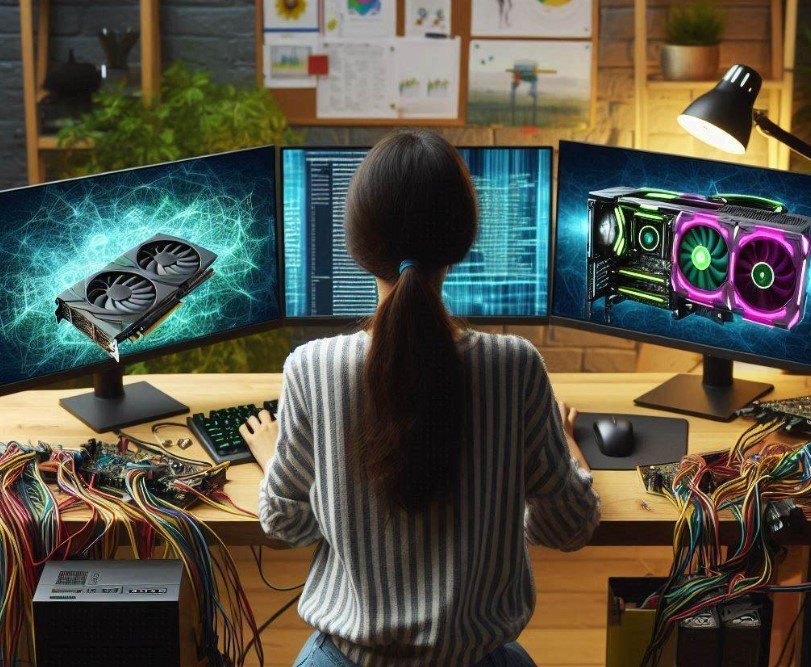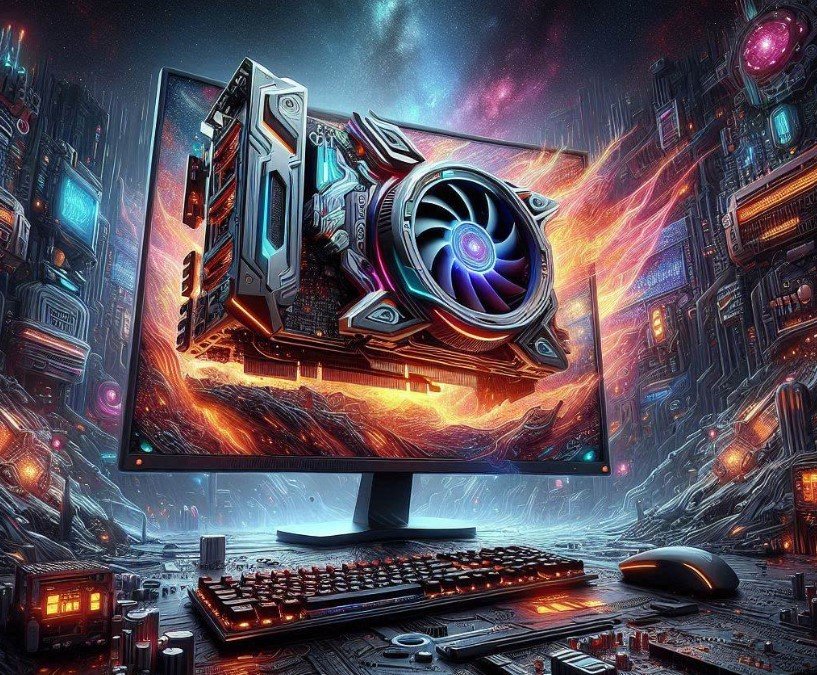Have you ever encountered iGPU Multi Monitor Not Showing Up? Your motherboard or CPU-connected monitor isn’t working because you have to deactivate the integrated graphic card by connecting a dedicated GPU to your computer. Once more, the iGPU needs to be enabled via the BIOS settings. In addition, malfunctioning cables, out-of-date drivers, defective ports on the motherboard or Display, or other hardware problems can be to blame.
iGPU Multi Monitor Not Showing Up
If you are having trouble with the iGPU multi-monitor not showing up, there may be a hardware issue with the motherboard, GPU, or monitor itself. You must ensure all cables are securely connected and verify that your monitor is powered on.

How To Fix iGPU Multi Monitor Not Showing Up?
There are numerous ways to fix No iGPU Multi-Monitor in BIOS. Check all physical connections to ensure cables are correctly attached, and monitors are powered on and configured to the correct input source.
Next, download the newest GPU drivers from Intel, AMD, or NVIDIA’s websites. You can access BIOS/UEFI settings by rebooting your computer and pressing Del, F2, or Esc during boot. Turn on integrated graphics and make sure your BIOS supports multiple monitors. Exit BIOS and go to Windows display settings after saving adjustments.
Right-click Display settings, then Detect to test if Windows can discover the extra monitors. Under the Multiple Displays menu, configure the monitors to Extend rather than Duplicate. Also, check Settings > Update & Security > Windows Update and install any updates.
Right-click the iGPU in Device Manager’s Display adapters area and pick Update driver to look for updated drivers automatically. Avoid yellow exclamation marks and error notices. Test various ports and cables to rule out defective connections if the problem persists.
It can also help to power cycle the system by turning off the computer and monitors, unplugging them, delaying a few minutes, and then rejoining and powering everything back on.
In Settings > System > Display > Advanced display settings, check that each monitor is identified and set to the correct resolution and refresh rate.
Resetting the BIOS/UEFI to default settings may fix configuration difficulties as a final resort. If none of these methods work, the GPU, motherboard, or displays may be defective, requiring technical support or hardware replacement.
Why iGPU Multi-Monitor Option Missing In B560 Chipset?
Only during UEFI boot will the IGPU be turned on. To accomplish that, you must use a UEFI NTFS USB stick, which you may create on your own with Rufus, to reinstall Windows.

Next, turn off the secure boot (clear, secure boot keys and switch to another os), turn off the CSM on your motherboard, boot your stick, and install EFI. Remember to set your Windows C drive (system disk) to GPT; it’s likely MBR now, but you can easily change it after installation.
Additionally, you cannot use Windows programs to back up your computer because doing so will cause it to state that your current computer is EFI and your previous one was BIOS.
What Is No IGPU Multi-Monitor Setting?
Take the following actions for the IGPU multi-monitor setting:
- Launch the Device Manager.
- To expand it, click or tap the arrow next to Display adapters.
- To turn the GPU on or off, right-click on it.
- If the GPU were disabled in Option Two’s BIOS/UEFI, it wouldn’t be seen in Device Manager.
- Tap or click on Disable device or Enable device (default).
Why iGPU Multi Monitor Not Available In BIOS?
The CPUs that end in -F don’t have an iGPU; if they do, it’s not turned on. The only way to enable the graphics ports on the motherboard’s rear I/O (the top ports on the vertical section) is to use a CPU that does not terminate in -F. By turning off the iGPU portion of the CPU and selling them for less money, they can sell CPUs that may have a flaw by using those -F CPUs.
However, we are also observing two issues with these pre-assembled systems: There are hardly any BIOS updates, and their custom BIOS may have some settings removed.
For instance, to avoid any overclocking that would interfere with their system-specific cooling design, some of those pre-built PCs have issues even with their default settings.
What is Multi Monitor Problem/BIOS Configuration?
Even compared to a single, massive ultra-wide, several monitors offer various benefits, such as increased productivity and desk location flexibility. However, things are only sometimes ideal. Occasionally, a second monitor you plug in won’t operate or will keep shrinking your game when you unintentionally go into it.

If you’ve followed our instructions on setting up multiple displays but are still having trouble, check out the list of the most typical multi-monitor issues below and how to resolve them.
Getting no signal to your new Display is the most straightforward issue to resolve, but it is still cause for concern. It indicates that although the Display is powered on, no visual data reaches it. You can try several remedies to address this issue’s many causes.
- Make Windows identify your monitor: It’s possible that Windows didn’t detect the connection of your second Display. Right-click the desktop and choose Display Settings from the pop-up menu that appears to make it check again. Click the Detect button under the display diagram in the window that appears.
- Switch the screen on and off: Some connection types dislike hot-swapping when a monitor is powered on. Switch the Display on and off again. It could only require that the video feed be identified and shown accurately.
- Check the connections between the cables; often, a loose cable is the source of no signal problems. To be sure, unplug and re-plug them if they appear securely fastened.
- Switch out your data cable: If you’re still using an older one like VGA or DVI-D, try a more recent standard like HDMI or DisplayPort. If the old cable has problems (bent pins, a short, exposed wire, etc.), you can try using a new one.
- Alter the graphics port: Try using a different port if your dedicated graphics card has numerous output ports. Ports themselves may occasionally malfunction or sustain damage. All you have to do to fix the issue is switch to another.
- Update your drivers: Windows 10 allows for multiple monitors, but your configuration might not be ideal. Sometimes, issues with no-signal errors can be resolved by making sure your system is running the most recent graphics drivers.
Why There Is No iGPU Option In ASUS UEFI BIOS?
Many reasons exist for the ASUS UEFI BIOS not to display the iGPU option. Some motherboards, primarily high-end gaming or professional ones, may not support integrated graphics.
Some CPUs, including Intel’s F-series and AMD Ryzen, lack integrated graphics. If there is a discrete GPU, the BIOS may turn off the iGPU to favor it.
The iGPU settings may be named differently or contained within other menus like Primary Display, Internal Graphics, IGD, or System Agent Configuration. Finally, old BIOS versions may not support the option, therefore, updating may be needed to reveal or improve GPU settings.
Why I Am Unable To Use Multiple Displays With iGPU And External GPU?
After you brought in a dedicated GPU, your integrated graphics were most likely disabled in the BIOS. First, open the device manager and see if the specialized GPU drivers are also included with the integrated graphics drivers.
You can use the second monitor by simply plugging it in if the integrated graphics driver is visible. Go into the BIOS and turn on integrated graphics if there isn’t a driver for it. Install the device’s driver next.
Why Is My Display Not Detecting 2 Monitors?
Second monitors are a great method for Windows users to boost productivity, but sometimes the computer needs to recognize them. Most people will ultimately encounter this common problem, but it is simple to resolve!

Force Detection Panels
Although Windows’ automatic display recognition typically operates without issues, you can specifically instruct Windows to search for newly connected displays.
This is helpful when using older connection standards, like VGA or DVI. These procedures can be used to recognize screens in Windows 11.
- From the context menu, choose Display Settings by right-clicking on the desktop.
- Your second monitor will only show up if it is detected.
- Select Detect at this point to see any accessible monitors appear.
- This window can be found by going to Start > Settings > Display.
Verify All of the Power
Make sure that everything is turned on and connected to a power source. Windows won’t identify the Display if the monitor or any intermediary device—like an active HDMI repeater—isn’t receiving power.
Suppose you have a convoluted configuration with intermediary devices like an HDMI repeater or USB dock; attempt connecting the Display without any of those components in the chain. This will enable you to determine whether the issue lies with one of those devices instead of Windows or the monitor itself.
Seek for Incorrect Connections
Verify again that everything is plugged in at the correct location. A frequent cause of this issue is the incorrect display output connection of the monitor. The majority of computer motherboards contain an HDMI or other display output.
Still, if your graphics card is discrete, you must connect the monitor to the output of the graphics card rather than the motherboard! Plug in every port you see to determine whether you use a graphics card.
How To Activate iGPU In BIOS?
If the ASUS UEFI BIOS does not provide an iGPU option, then the following fast tips should be followed:
- Boot to the firmware settings of the UEFI BIOS. To choose between Auto, Enabled, or Disabled for the iGPU Multi-Monitor drop-down, navigate to your iGPU settings in BIOS/UEFI. For precise instructions on turning the iGPU on or off, see the manual with your motherboard, as each manufacturer will have different requirements.
- To apply, click or press the Save Changes & Reset button after selecting the Exit tab. The precise methods to save modifications and exit depend on the motherboard manufacturer, so you must consult the instructions.
How To Enable iGPU Multi-Monitor?
- Restart your PC and return to the ASUS ROG MAXIMUS XIII HERO motherboard’s BIOS.
- Accessing the Boot page and selecting the CSM (Compatibility Support Module) option will reveal that the Launch CSM option is greyed out and disabled.

Note: Even though UEFI was unnecessary for the iGPU on other Asus motherboards, turning this setting back on would turn off your CPU’s graphics again.
- Select System Agent (SA) Configuration under the Advanced tab.
- Once more, you must enable the VT-d setting to use GPU passthrough. Don’t alter the value in any other case.
- After that, select Graphics Configuration.
As you can see, since your processor’s graphics component is turned on, three additional settings have been added to the Graphics Configuration section.
- Primary Display: This feature lets you select which graphics card to boot up when the computer turns on.
- Thus, you can use your hardware graphics card or the graphics component of your Intel processor.
- iGPU Multi-Monitor: This feature lets you use external graphics cards (Nvidia, ATI, etc.) and internal graphics cards (Intel UHD Graphics) or only the one you’ve chosen.
- DVMT Pre-Allocated: this feature lets you modify the amount of video RAM that the Intel processor’s graphics unit uses.
- The CPU Graphics option is now available if you look at the list of possible settings for the Primary Display setting.
- If you choose this CPU Graphics option, your computer will begin initializing the processor’s graphics component.
- Select Enabled to activate the iGPU Multi-Monitor configuration.
How To Enable iGPU Multi-Monitor To Have Dual-Screen Display?
Please follow the following steps to enable iGPU Multi-Monitor:
- To access BIOS Advanced Mode, press the [F7] key after turning on the system and pressing the delete key on the keyboard.
- Select [NB Configuration] from the [Advanced] page.
- Select [IGFX Multi-Monitor] and set the option to [Enabled].
- To save the changed selections, hit the [F10] key and select [Ok]. The IGFX Multi-Monitor configuration is finished after the computer restarts.
How Do I Enable IGPU Multi-Monitor On B550/A520 Series Motherboard?
Follow these procedures to activate and set up iGPU multi-monitor capability on your B550 or A520 series motherboard.
Enter BIOS/UEFI to activate iGPU multi-monitor functionality on B550 or A520 series motherboards. Press Del, F2, or Esc during boot to restart your computer. After entering the BIOS, select Advanced, System Agent, Chipset, or NB Configuration.

Find Integrated Graphics or IGD Multi-Monitor and activate it. In some BIOS versions, you may need to set the Primary Display to iGPU or Integrated Graphics.
Press F10 and confirm to save and leave the BIOS after these changes. Connect your monitors to the motherboard and discrete GPU video outputs.
Start Windows Display settings by right-clicking the desktop after restarting. To see if Windows identifies the extra monitors, click Detect, arrange them, and select Extend under Multiple Displays.
How To Enable iGPU In BIOS ASUS?
An integrated graphics processor, sometimes an onboard graphics processing unit, is a feature of some ASUS motherboards that allows the computer to output video to a monitor.
The motherboard will use the dedicated graphics card—the card placed in an expansion slot—for video output in place of the onboard GPU if the onboard GPU is not activated in the basic input/output system (BIOS).
If the specialized card breaks down, you can use the onboard GPU to regain the PC’s graphics. But remember that dedicated graphics are frequently superior to integrated graphics, so if your company runs graphics-intensive applications on an ASUS PC, you might notice a drop in video performance.
- Turn the computer on or restart it. To load the BIOS, press Del when you see the ASUS logo.
- Choose Advanced Mode, followed by Exit/Advanced Mode. Choose the Advanced tab by using the directional pad.
- Navigate to the System Agent Configuration section and hit Enter.
- Press + or – after selecting Initiate Graphics Adapter to modify the value to iGPU.
- Choose exit, followed by Save Changes & Reset to force the machine to restart and utilize the integrated graphics device.
How To Enable Dual Monitors In BIOS ASUS?
To adjust the primary and secondary displays, check BIOS Setup:
- To access BIOS Setup upon boot, press F2.
- Select Video under Advanced > Devices.
- Select the device you wish to use as the primary IGD Primary Video Port.
- Select the device you want to use as the secondary IGD Secondary Video Port.
- To save press F10 and close BIOS Setup,.
The following can be tried if this doesn’t fix the problem:
- Use the NUC’s second HDMI port to connect one Display.
- Just connect the DisplayPort input on the other monitor to the Thunderbolt/DP port on the NUC.
Conclusion
If your system has an integrated graphics card (IGP), it will typically automatically disable. However, you can still connect your HDMI cable or any other cable you use for your monitors to your motherboard, which may still produce an output.
However, it will only use integrated graphics, negatively impacting performance. If you connect the cable to the GPU and install the appropriate drivers, the computer will use the graphics card for output and the GPU for processing graphics.
Therefore, if you are using the GPU, all you need to do is make sure that the connections to your monitors are in the GPU, not the motherboard.
Frequently Asked Questions
Why isn’t my multi-monitor operating correctly?
Faulty video cables, improper monitor settings, improper Windows settings, and out-of-date video drivers can all lead to multiple display problems.
Why Is My iGPU not being detected?
Normally, when a separate GPU is installed on a desktop computer, the iGPU is automatically disabled. If the iGPU is functioning, there must be a discrete GPU issue; if it weren’t, the iGPU would be disabled. Try starting in safe mode, OP.
Can I access the BIOS without an iGPU?
BIOS can function without a GPU because it just needs a CPU and RAM. However, you won’t be able to see what you’re doing without a graphics unit.






